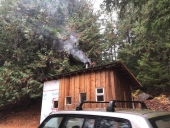Bruce, the Kuznetsov type with bell above bell
http://www.stove.ru/index.php?lng=1&rs=16
are meant to store heat evenly at all levels into the room. Because heat is radiated from the bell, it is better to do so at human height, than below the ceiling.
More than two bell, in my opinion, is to be kept for very big systems. And a barrel, should be followed only by a bell, again, according to my own highly valuable opinion

What you need to know, is the heat you have left after the covered barrel. To assume what you need in term of bell.
Or do it by ISA. For example, a 6 batch can cope with 5 to 6m² of ISA. (internal surface area, which extracts the heat)
From the few experiments with J tubes, that some guys have done. You can say 4m² for a 6"J (that's about 40 sqft)
I think 6m² has been done with an 8 J This is the total of the 2 bells.
In your case, you have a barrel at first, so this is 1.89m² to retract from the total.

















































